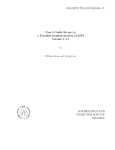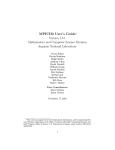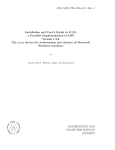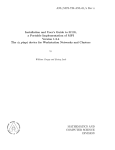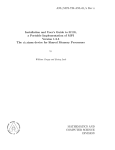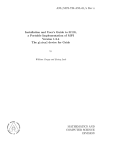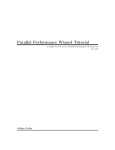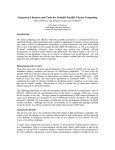Download ANL/MCS-TM-ANL-98/xx User's Guide for MPE
Transcript
ANL/MCS-TM-ANL-98/xx
User’s Guide for MPE: Extensions for MPI Programs
by
Anthony Chan, William Gropp, and Ewing Lusk
TIONAL L
AB
NA
ARGON
NE
RY
ATO
OR
NI
•U
O•
+
*
)
E
V
AG
(
RS
'
&
HI
C
%
IT Y
!
"
$
OF
#
C
MATHEMATICS AND
COMPUTER SCIENCE
DIVISION
Contents
Abstract
1
1 Introduction
1
2 The
2.1
2.2
2.3
2.4
2.5
.
.
.
.
.
.
.
.
.
.
.
.
.
.
.
.
.
.
.
.
.
.
.
.
.
.
.
.
.
.
.
.
.
.
.
.
.
.
.
.
.
.
.
.
.
.
.
.
.
.
.
.
.
.
.
.
.
.
.
.
.
.
.
.
.
.
.
.
.
.
.
.
.
.
.
.
.
.
.
.
.
.
.
.
.
.
.
.
.
.
.
.
.
.
.
.
.
.
.
.
.
.
.
.
.
.
.
.
.
.
.
.
.
.
.
.
.
.
.
.
.
.
.
.
.
.
.
.
.
.
.
.
.
.
.
.
.
.
.
.
.
.
.
.
.
.
.
.
.
.
.
.
.
.
.
.
.
.
.
.
.
.
.
.
.
.
.
.
.
.
.
.
.
.
.
.
.
.
.
.
.
.
.
.
.
.
.
.
.
.
.
.
.
.
.
1
1
2
2
3
3
3
3
4
4
5
5
6
7
8
8
.
.
.
.
.
.
.
.
.
.
.
.
.
.
.
.
.
.
.
.
.
.
.
.
.
.
.
.
.
.
.
.
.
.
.
.
.
.
.
.
.
.
.
.
.
.
.
.
.
.
.
.
.
.
.
.
.
.
.
.
.
.
.
.
.
.
.
.
.
.
.
.
.
.
.
.
.
.
.
.
.
.
.
.
.
.
.
.
.
.
.
.
.
.
.
.
.
.
.
.
.
.
.
.
.
.
.
.
.
.
.
.
.
.
.
.
.
.
.
.
.
.
.
.
.
.
.
.
.
.
.
.
.
.
.
.
.
.
.
.
.
.
.
10
11
11
12
12
12
12
13
13
13
13
14
4 Debugging MPI programs with built-in tools
4.1 Error handlers . . . . . . . . . . . . . . . . . . . . . . . . . . . . . . . . . .
4.2 Contents of the library files . . . . . . . . . . . . . . . . . . . . . . . . . . .
14
14
14
A Installing MPE
A.1 Configuration . . . . . . . . . . . . . . . . . . . . . . . . . . . .
A.1.1 Configuration Model . . . . . . . . . . . . . . . . . . . .
A.1.2 Build Options and Features . . . . . . . . . . . . . . . .
A.2 Installation Instructions . . . . . . . . . . . . . . . . . . . . . .
A.2.1 Configuring as part of the MPICH configure . . . . . . . .
A.2.2 Configuring as part of an existing MPI implementation
A.3 Install/Uninstall Scripts . . . . . . . . . . . . . . . . . . . . . .
16
16
16
17
19
19
19
21
2.6
2.7
2.8
2.9
MPE library of useful extensions
Logfile Creation . . . . . . . . . . . . . . . .
Logfile Formats . . . . . . . . . . . . . . . .
Parallel X Graphics . . . . . . . . . . . . . .
Other MPE Routines . . . . . . . . . . . . .
Profiling Libraries . . . . . . . . . . . . . .
2.5.1 Accumulation of Time Spent in MPI
2.5.2 Automatic Logging . . . . . . . . . .
2.5.3 Customized Logging . . . . . . . . .
2.5.4 Real-Time Animation . . . . . . . .
Logfile Viewers . . . . . . . . . . . . . . . .
2.6.1 Upshot and Nupshot . . . . . . . . .
2.6.2 Jumpshot-2 and Jumpshot-3 . . . .
Accessing the profiling libraries . . . . . . .
Automatic generation of profiling libraries .
Tools for Profiling Library Management . .
. . . . .
. . . . .
. . . . .
. . . . .
. . . . .
routines
. . . . .
. . . . .
. . . . .
. . . . .
. . . . .
. . . . .
. . . . .
. . . . .
. . . . .
3 Using MPE
3.1 Directory Structure . . . . . . . . . . . . . . . .
3.2 Example Makefile . . . . . . . . . . . . . . . . .
3.3 Environmental Variables . . . . . . . . . . . . .
3.4 Utility Programs . . . . . . . . . . . . . . . . .
3.4.1 Log Format Converters . . . . . . . . .
3.4.2 Log Format Print Programs . . . . . . .
3.4.3 Display Program Selector . . . . . . . .
3.5 Using MPE in MPICH . . . . . . . . . . . . . . .
3.5.1 Compilation and Linkage . . . . . . . .
3.5.2 Inheritance of Environmental Variables
3.5.3 Viewing Logfiles . . . . . . . . . . . . .
iii
.
.
.
.
.
.
.
.
.
.
.
.
.
.
.
.
.
.
.
.
.
.
.
.
.
.
.
.
.
.
.
.
.
.
.
.
.
.
.
.
.
.
.
.
.
.
.
.
.
.
.
.
.
.
.
.
.
.
.
.
.
.
.
.
.
.
.
.
.
.
.
.
.
.
.
.
.
.
.
.
.
.
B Installing Java for Jumpshots
B.1 Java requirements . . . . . . . . . . . . . . . . . . . . . . . . . . . . . . . .
22
22
C Automatic generation of profiling libraries
C.1 Writing wrapper definitions . . . . . . . . . . . . . . . . . . . . . . . . . . .
24
24
D Manual Pages
28
Acknowledgments
29
References
31
iv
Abstract
The MPE extensions provide a number of useful facilites for MPI programmers.
These include several profiling libraries to collect information on MPI programs, including logfiles for post-mortum visualization and real-time animation. Also included
are routines to provide simple X window system graphics to parallel programs. MPE
may be used with any implemenation of MPI.
1
Introduction
The Message Passing Interface (MPI) [4] provides a strong basis for building parallel programs. One of its design goals was to enable the construction of parallel software libraries,
thus helping to solve the problem of developing large parallel applications. The MPE (MultiProcessing Environment) library exploits the features of MPI to provide a number of useful
facilities, including performance and correctness debugging, graphics, and some common
utility routines.
The MPE library was developed for the MPICH [1] implementation of MPI (and is included with the MPICH distribution), but can and has been used with any MPI implementation. Installation instructions for MPE are in Appendix A.
2
The MPE library of useful extensions
Currently the main components of the MPE are
• A set of routines for creating logfiles for examination by various graphical visualization
tools : upshot, nupshot, Jumpshot-2 or Jumpshot-3.
• A shared-display parallel X graphics library.
• Routines for sequentializing a section of code being executed in parallel.
• Debugger setup routines.
2.1
Logfile Creation
MPE provides several ways to generate logfiles that describe the progress of a computation.
These logfiles can be viewed with one of the graphical tools distributed with MPE. In
addition, you can customize these logfiles to add application-specific information.
The easiest way to generate logfiles is to link your program with a special MPE library
that uses the profiling feature of MPI to intercept all MPI calls in an application.
You can create customized logfiles for viewing by calls to the various MPE logging routines.
For details, see the MPE man pages. An example is shown in Section 2.5.3.
1
2.2
Logfile Formats
MPE currently provides three different logfile formats: ALOG, CLOG and SLOG. ALOG is
provided for backward compatibility purposes only, and stores events as ASCII text. CLOG
is similar to ALOG, but stores data in a binary format (essentially the same as “external32”
in MPI-IO or as the format specified for Java). SLOG is an abbreviation for Scalable LOGfile
format and stores data as states (essentially an event with a duration) in a special binary
format chosen to help visualization programs handle very large (multi-Gigabyte) log files.
Each of these log file formats has one or more visualization programs associated with
it. The ALOG format is understood by nupshot. The CLOG format is understood by
nupshot and jumpshot, a Java-based visualization tool. SLOG and Jumpshot-3 are capable
of handling logfiles containing gigabytes of data [5].
2.3
Parallel X Graphics
MPE provides a set of routines that allows you to display simple graphics with the X
Window System. In addition, there are routines for input, such as getting a region defined
by using the mouse. A sample of the available graphics routines are shown in Table 1. For
arguments, see the man pages.
MPE Open graphics
MPE Close graphics
MPE Update
MPE
MPE
MPE
MPE
MPE
MPE
MPE
MPE
MPE
MPE
Draw point
Draw points
Draw line
Draw circle
Fill rectangle
Draw logic
Line thickness
Make color array
Num colors
Add RGB color
MPE Get mouse press
MPE Get drag region
Control Routines
(collectively) opens an X display
Closes a X11 graphics device
Updates an X11 display
Output Routines
Draws a point on an X display
Draws points on an X display
Draws a line on an X11 display
Draws a circle
Draws a filled rectangle on an X11 display
Sets logical operation for new pixels
Sets thickness of lines
Makes an array of color indices
Gets the number of available colors
Add a new color
Input Routines
Get current coordinates of the mouse
Get a rectangular region
Table 1: MPE graphics routines.
You can find an example of the use of the MPE graphics library in the directory mpich/
mpe/contrib/mandel. Enter
make
mpirun -np 4 pmandel
2
to see a parallel Mandelbrot calculation algorithm that exploits several features of the MPE
graphics library.
2.4
Other MPE Routines
Sometimes during the execution of a parallel program, you need to ensure that only a few
(often just one) processor at a time is doing something. The routines MPE_Seq_begin and
MPE_Seq_end allow you to create a “sequential section” in a parallel program.
The MPI standard makes it easy for users to define the routine to be called when an
error is detected by MPI. Often, what you’d like to happen is to have the program start
a debugger so that you can diagnose the problem immediately. In some environments, the
error handler in MPE_Errors_call_dbx_in_xterm allows you to do just that. In addition,
you can compile the MPE library with debugging code included. (See the -mpedbg configure
option.)
2.5
Profiling Libraries
The MPI profiling interface provides a convenient way for you to add performance analysis
tools to any MPI implementation. We demonstrate this mechanism in MPICH, and give you
a running start, by supplying three profiling libraries with the MPICH distribution. MPE
users may build and use these libraries with any MPI implementation.
2.5.1
Accumulation of Time Spent in MPI routines
The first profiling library is simple. The profiling version of each MPI Xxx routine calls
PMPI Wtime (which delivers a time stamp) before and after each call to the corresponding
PMPI Xxx routine. Times are accumulated in each process and written out, one file per
process, in the profiling version of MPI Finalize. The files are then available for use in
either a global or process-by-process report. This version does not take into account nested
calls, which occur when MPI Bcast, for instance, is implemented in terms of MPI Send and
MPI Recv. The file ‘mpe/src/trc_wrappers.c’ implements this interface, and the option
-mpitrace to any of the compilation scripts (e.g., mpicc) will automatically include this
library.
2.5.2
Automatic Logging
The second profiling library is called MPE logging libraries which generate logfiles, they
are files of timestamped events for CLOG and timestamped states for SLOG. During execution, calls to MPE Log event are made to store events of certain types in memory, and
these memory buffers are collected and merged in parallel during MPI Finalize. During
execution, MPI Pcontrol can be used to suspend and restart logging operations. (By default, logging is on. Invoking MPI Pcontrol(0) turns logging off; MPI Pcontrol(1) turns
it back on again.) The calls to MPE Log event are made automatically for each MPI call.
3
You can analyze the logfile produced at the end with a variety of tools; these are described
in Sections 2.6.1 and 2.6.2.
2.5.3
Customized Logging
In addition to using the predefined MPE logging libraries to log all MPI calls, MPE logging
calls can be inserted into user’s MPI program to define and log states. These states are
called user defined states. States may be nested, allowing one to define a state describing a
user routine that contains several MPI calls, and display both the user-defined state and the
MPI operations contained within it. The routine MPE_Log_get_event_number should be
used to get unique event numbers1 from the MPE system. The routines MPE_Describe_state and MPE_Log_event are then used to describe user-defined states. The following
example illustrates the use of these routines.
int eventID_begin, eventID_end;
...
eventID_begin = MPE_Log_get_event_number();
eventID_end
= MPE_Log_get_event_number();
...
MPE_Describe_state( eventID_begin, eventID_end, "Amult", "bluegreen" );
...
MyAmult( Matrix m, Vector v )
{
/* Log the start event along with the size of the matrix */
MPE_Log_event( eventID_begin, m->n, (char *)0 );
... Amult code, including MPI calls ...
MPE_Log_event( eventID_end, 0, (char *)0 );
}
The logfile generated by this code will have the MPI routines within the routine MyAmult
indicated by a containing bluegreen rectangle. The color used in the code is chosen from
the file, ‘rgb.txt’, provided by X server installation, e.g. ‘rgb.txt’ is located in ‘/usr/
X11R6/lib/X11’ on Linux.
If the MPE logging library, ‘liblmpe.a’, is not linked with the user program, MPE_Init_log must be called before all other MPE calls and MPE_Finish_log must be called
after all the MPE calls. The sample programs ‘cpilog.c’ and ‘fpi.f’, available in MPE
source directory ‘contrib/test’ or the installed directory ‘share/examples’, illustrate the
use of these MPE routines.
2.5.4
Real-Time Animation
The third library does a simple form of real-time program animation. The MPE graphics
library contains routines that allow a set of processes to share an X display that is not
associated with any one specific process. Our prototype uses this capability to draw arrows
1
This is important if you are writing a library that uses the MPE logging routines.
4
that represent message traffic as the program runs. Note that MPI programs can generate
communication events far faster than most X11 servers can display the arrows that represent
those events.
2.6
Logfile Viewers
There are 4 graphical visualization tools distributed with MPE, they are upshot, nupshot,
Jumpshot-2 and Jumpshot-3. Out of these 4 Logfile Viewers, only 3 viewers are built by
MPE. They are upshot, Jumpshot-2 and Jumpshot-3.
2.6.1
Upshot and Nupshot
One tool that we use is called upshot, which is a derivative of Upshot [3], written in Tcl/Tk
(version 4). A screen dump of Upshot in use is shown in Figure 1. It shows parallel time
Figure 1: A screendump from upshot
lines with process states, like one of the paraGraph [2]. The view can be zoomed in or out,
5
horizontally or vertically, centered on any point in the display chosen with the mouse. In
Figure 1, the middle window has resulted from zooming in on the upper window at a chosen
point to show more detail. The window at the bottom of the screen show a histogram of
state durations, with several adjustable parameters.
Nupshot is a version of upshot that is faster but requires an older version of Tcl/Tk
(version 3, to be precise). Because of this limitation, Nupshot is not built by default in
current MPE.
2.6.2
Jumpshot-2 and Jumpshot-3
There are 2 versions of Jumpshot distributed with the MPE. They are Jumpshot-2 and
Jumpshot-3, which have evolved from Upshot and Nupshot. Both are written in Java and
are graphical visualization tools for interpreting binary tracefiles which displays them onto
the display, as shown in Figure 2. For Jumpshot-2, see [6] for more screenshots and details.
For Jumpshot-3, See file ‘mpe/viewers/jumpshot-3/doc/TourStepByStep.pdf’ for a brief
introduction of the tool.
As the size of the logfile increases, Jumpshot-2’s performance decreases, and can ultimately result in Jumpshot-2 hanging while it is reading in the logfile. It is hard to determine
at what point Jumpshot-2 will hang, but we have seen it with files as small as 10MB. When
CLOG file is about 4MB in size, the performance of Jumpshot-2 starts to deterioate significantly. There is a current research effort that will result in the ability to make the
Java based display program significantly more scalable. The results of the first iteration of
this effort are SLOG which supports scalable logging of data and Jumpshot-3 which reads
SLOG.
Figure 2: Jumpshot-1 Display
6
2.7
Accessing the profiling libraries
If the MPE libraries have been built, it is very easy to access the profiling libraries. The
configure in the MPE directory determines the link path necessary for each profiling library
(which varies slightly for each MPI implementation). These variables are first substituted
in the Makefile in the directory ‘mpe/contrib/test’. The Makefile is then installed into
directory ‘share/examples’ during the final installation process. This information is placed
in the following variables:
• PROF LIBS - The compiler flag needed to link with the mpe library only. The link
path is -lmpe -lpmpich or -lmpe -lpmpi depending on the MPI implementation.
• LOG LIBS - The compiler flag needed to link with the logging libraries. The logging
libraries log all MPI calls and generate log file. The link path is -llmpe $PROF LIB.
• TRACE LIBS - The compiler flag needed to link with the tracing library. The tracing library will trace all MPI calls. Each MPI call is preceded by a line that contains
the rank in MPI_COMM_WORLD of the calling process, and followed by another line indicating that the call has completed. Most send and receive routines also indicate the
values of count, tag, and partner (destination for sends, source for receives). Output
is to standard output. The link path is -ltmpe $PROF LIB.
• ANIM LIBS - The compiler flag needed to link with the animation library. The
animation library produces a real-time animation of the program. This requires the
MPE graphics, and uses X11 Window System operations. You may need to provide
a specific path for the X11 libraries (instead of -lX11). The link path is -lampe
$PROF LIB -lX11.
• F2CMPI LIBS - The compiler flag needed to link Fortran to C MPI wrapper library with all the above mentioned libraries. For MPICH, this should be -lfmpich.
Otherwise, it could be -lmpe f2cmpi, MPE’s own Fortran to C MPI wrapper library.
• FLIB PATH - The full compiler flag needed to link Fortran MPI programs with the
logging library.
As part of the make process, small programs ‘cpi.c’ and ‘fpi.f’ are linked with each
profiling library. The result of each link test will be written as part of the make output. If
the link test is successful, then these link paths should be used for user programs as well.
If the MPI implementation being used is MPICH, then adding compiler flag -mpilog
to MPICH’s mpicc/mpif77 will automatically link user program with MPE’s logging libraries
(-llmpe -lmpe). Library link path -lpmpich is also linked with the MPI profiling interface
when -mpilog flag is used
If a Fortran MPI program is linked with MPICH, it is necessary to include the library
‘-lfmpich’ ahead of the profiling libraries. This allows C routines to be used for implementing the profiling libraries for use by both C and Fortran programs. For example, to
generate log files in a Fortran program, the library linkage flag is -lfmpich -llmpe -lmpe
-lpmpich. Using mpif77 -mpilog will automatically link with all these libraries.
7
If the MPI implementation being used is not MPICH, it is necessary to include the library ‘-lmpe f2cmpi’ (MPE’s own Fortran to C MPI wrapper library) instead of library
‘-lfmpich’. Again this has to be linked before any of the profiling libraries. So the compiler
linkage flag will be -lmpe f2cmpi -llmpe -lmpe -lpmpi -lmpi.
It is possible to combine automatic logging with manual logging. Automatic logging will
log all MPI calls and is achieved by linking with $LOG LIBS. Manual logging is achieved by
the user inserting calls to the MPE routines around MPI calls. This way, only the chosen MPI
calls will be logged. However, if a combination of these two types of logging is preferred, then
the user must NOT call MPE Init log and MPE Finish log in the user program. Because
in the linked logging library, MPI Init will call MPE Init log and MPI Finalize will call
MPE Finish log.
2.8
Automatic generation of profiling libraries
For each of these libraries, the process of building the library was very similar. First,
profiling versions of MPI Init and MPI Finalize must be written. The profiling versions
of the other MPI routines are similar in style. The code in each looks like
int MPI_Xxx( . . . )
{
do something for profiling library
retcode = PMPI_Xxx( . . . );
do something else for profiling library
return retcode;
}
We generate these routines by writing the “do something” parts only once, in schematic
form, and then wrapping them around the PMPI calls automatically. It is thus easy to
generate profiling libraries. See the README file in mpich/mpe/profiling/wrappergen or
Appendix C.
Examples of how to write wrapper templates are located in the mpe/profiling/lib
subdirectory. There you will find the source code (the .w files) for creating the three
profiling libraries described above. An example Makefile for trying these out is located in
the mpe/profiling/examples directory.
2.9
Tools for Profiling Library Management
The sample profiling wrappers for MPICH are distributed as wrapper definition code. The
wrapper definition code is run through the wrappergen utility to generate C code (see
Section 2.8. Any number of wrapper definitions can be used together, so any level of
profiling wrapper nesting is possible when using wrappergen.
A few sample wrapper definitions are provided with MPICH:
timing Use MPI_Wtime() to keep track of the total number of calls to each MPI function,
8
and the time spent within that function. This simply checks the timer before and
after the function call. It does not subtract time spent in calls to other functions.
logging Create logfile of all pt2pt function calls.
vismess Pop up an X window that gives a simple visualization of all messages that are
passed.
allprof All of the above. This shows how several profiling libraries may be combined.
Note: These wrappers do not use any mpich-specific features besides the MPE graphics
and logging used by ‘vismess’ and ‘logging’, respectively. They should work on any MPI
implementation.
You can incorporate them manually into your application, which involves three changes
to the building of your application:
• Generate the source code for the desired wrapper(s) with wrappergen. This can be a
one-time task.
• Compile the code for the wrapper(s). Be sure to supply the needed compile-line parameters. ‘vismess’ and ‘logging’ require the MPE library (‘-lmpe’), and the ‘vismess’
wrapper definition requires MPE GRAPHICS.
• Link the compiled wrapper code, the profiling version of the mpi library, and any
other necessary libraries (‘vismess’ requires X) into your application. The required
order is:
$(CLINKER)
<application object files...> \
<wrapper object code> \
<other necessary libraries (-lmpe)> \
<profiling mpi library (-lpmpi)> \
<standard mpi library (-lmpi)>
To simplify it, some sample makefile sections have been created in ‘mpich/mpe/profiling/
lib’:
Makefile.timing - timing wrappers
Makefile.logging - logging wrappers
Makefile.vismess - animated messages wrappers
Makefile.allprof - timing, logging, and vismess
To use these Makefile fragments:
1. (optional) Add $(PROF_OBJ) to your application’s dependency list:
myapp:
myapp.o $(PROF_OBJ)
9
2. Add $(PROF_FLG) to your compile line CFLAGS:
CFLAGS = -O $(PROF_FLG)
3. Add $(PROF_LIB) to your link line, after your application’s object code, but before
the main MPI library:
$(CLINKER) myapp.o -L$(MPIR_HOME)/lib/$(ARCH)/$(COMM) $(PROF_LIB) -lmpi
4. (optional) Add $(PROF_CLN) to your clean target:
rm -f *.o *~ myapp $(PROF_CLN)
5. Include the desired Makefile fragment in your makefile:
include $(MPIR_HOME)/mpe/profiling/lib/Makefile.logging
(or
#include $(MPIR_HOME)/mpe/profiling/lib/Makefile.logging
if you are using the wildly incompatible BSD 4.4-derived make)
3
Using MPE
The Multi-Processing Environment (MPE) attempts to provide programmers with a complete suite of performance analysis tools for their MPI programs based on post processing
approach. These tools include a set of profiling libraries, a set of utility programs, and a
set of graphical tools.
The first set of tools to be used with user MPI programs is profiling libraries which
provide a collection of routines that create log files. These log files can be created manually
by inserting MPE calls in the MPI program, or automatically by linking with the appropriate
MPE libraries, or by combining the above two methods (see Section 2.5.3). Currently, MPE
offers the following three profiling libraries.
• Tracing Library: This library traces all MPI calls. Each MPI call is preceded by a
line that contains the rank in MPI_COMM_WORLD of the calling process, and followed by
another line indicating that the call has completed. Most send and receive routines
also indicate the values of count, tag, and partner (destination for sends, source for
receives). Output is to standard output.
• Animation Libraries: A simple form of real-time program animation that requires
X window routines.
10
• Logging Libraries: The most useful and widely used profiling libraries in MPE. They
form the basis to generate log files from user MPI programs. There are currently three
different log file formats allowed in MPE. The default log file format is CLOG. It is
basically a collection of events with single timestamps. And there is ALOG which
is provided for backward compatibility reason and it is not being developed. And
the most powerful one is SLOG, stands for Scalable LOGfile format, which can be
converted from CLOG file after CLOG file has been generated (preferred approach),
or can be generated directly when MPI program is executed (through setting the
environmental variable MPE_LOG_FORMAT to SLOG).
The set of utility programs in MPE includes log format converter (e.g. clog2slog),
logfile print (e.g. slog print) and logfile viewer wrapper, logviewer, which selects the
correct graphical tool to display the logfile based on the logfile’s file extension.
Currently, MPE’s graphical tools includes three display programs, upshot for ALOG,
Jumpshot-2 for CLOG and Jumpshot-3 for SLOG. The logviewer script eliminates the need
for user to remember the relationship between logfile formats and display programs.
3.1
Directory Structure
The final install directory contains the following subdirectories. In terms of usage of MPE,
user usually only need to know about the files that have been installed in ‘include/’, ‘lib/’
and ‘bin/’.
include/ contains all the include files that user program needs to read.
lib/ contains all the libraries that user program needs to link with.
bin/ contains all the utility programs that user needs to use.
sbin/ contains the MPE uninstall script to uninstall the installation.
share/ contains user read-only data. Besides ‘share/examples/’, user usually does not
need to know the details of other subdirectories.
3.2
Example Makefile
‘share/examples’ contains some very useful and simple example programs and ‘Makefile’
which illustrates the usage of MPE routines and the linkage of MPE libraries to generate
logfiles. In most cases, users can simply copy the ‘share/examples/Makefile’ to their
home directory, and do a make to compile the suggested targets. Users don’t need to copy
the ‘.c’ and ‘.f’ files when MPE has been compiled with a make that has VPATH support.
The created executables can be launched with mpirun provided by the MPI implementation
to generate sample logfiles.
11
3.3
Environmental Variables
There are 2 environmental variables, TMPDIR and MPE_LOG_FORMAT, that user may need to
set before the generation of logfiles :
MPE LOG FORMAT: determines the format of the logfile generated from the execution of application linked with MPE logging libraries. The allowed value for MPE_LOG_FORMAT
are CLOG, SLOG and ALOG. When MPE_LOG_FORMAT is not set, CLOG is assumed.
TMPDIR : specifies a directory to be used as temporary storage for each process. By
default, when TMPDIR is not set, ‘/tmp’ will be used. When user needs to generate a
very large logfile for long-running MPI job, user needs to make sure that TMPDIR is
big enough to hold the temporary logfile which will be deleted if the merged logfile
can be created successfully. In order to minimize the overhead of the logging to the
MPI program, it is highly recommended user to use a local file system for TMPDIR.
Note : The final merged logfile will be written back to the file system where process
0 is running.
3.4
Utility Programs
In ‘bin/’, user can find several useful utility programs when manipulating logfiles. These
includes log format converters, e.g. clog2slog, log format print programs, e.g. slog print,
and a script to launch display program, logviewer.
3.4.1
Log Format Converters
clog2slog: A CLOG to SLOG logfile converter. Since the automatic generation of SLOG
file through setting of environmental variable MPE_LOG_FORMAT to SLOG may not
work for some non well-behaved MPI programs, using the logfile format converter
can generate extra diagnostic information about the condition of the logfile. Also the
converter allows one to adjust certain parameters of the logfile, like frame size which is
the segment of the logfile to be displayed by Jumpshot-3’s Time Line window. For non
well behaved MPI program, one may need to increase the frame size from the default
64KB to a bigger value. For more information about the converter, do clog2slog -h.
clog2alog: A CLOG to ALOG logfile converter. It is provided here for backward compatibility purpose.
3.4.2
Log Format Print Programs
slog print: a stdout print program for SLOG file. It serves to check the content of the
logfile. If the SLOG file is too big, it may not be useful to use slog print. Also,
when slog is not complete, slog print won’t work. So it serves as a simple test to
check if the SLOG file is generated completely.
clog print: a stdout print program for CLOG file.
12
3.4.3
Display Program Selector
logviewer: the script which involves appropriate viewer based on the file extension of logfile. For instance, if the logfile is foo.slog, logviewer will invoke Jumpshot-3 to display
the logfile. Jumpshot-3 resides in ‘share/’. For more information of logviewer, do
logviewer -help to list all available options.
3.5
Using MPE in MPICH
MPE has been seamlessly integrated into MPICH distribution, so user may find it easier to
use MPE when using it with MPICH. Here are the differences of using MPE with MPICH and
with other MPI implementations.
3.5.1
Compilation and Linkage
MPICH provides scripts to help users to compile and link C/C++ and F77/F90 programs.
They are mpicc for C programs, mpiCC for C++ programs, mpif77 for F77 and mpif90 for
F90 programs. In addition, these 4 scripts allows special options to be used to link with
MPE profiling libraries. These options are :
-mpitrace to compile and link with tracing library.
-mpianim to compile and link with animation libraries.
-mpilog to compile and link with logging libraries.
For instance, the following command creates executable, fpilog, which generates logfile
when it is executed.
mpif77 -mpilog -o fpilog fpilog.f
For other MPI implementations, user needs to compile and link their application with
MPE profiling libraries explicitly as shown in the example makefile.
3.5.2
Inheritance of Environmental Variables
MPE relies on certain environmental variables (e.g. TMPDIR). These variables determine
how MPE behaves. It is important to make sure that all the MPI processes receive the
intended value of environmental variables. The complication of this issue comes from the
fact that MPICH contains many different devices for different platforms, some of these devices
have a different way of passing of environmental variables to other processes. The often
used devices, like ch_p4 and ch_shmem, do not require special attention to pass the value of
the environmental variable to spawned processes. The spawned process inherits the value
from the launching process as long as the environmental variable in the launching process
is set. But this is not true for all the devices, for instance, the ch_p4mpd device may require
a special option of mpirun to be used to set the environmental variables to all processes.
13
mpirun -np N cpilog -MPDENV- MPE_LOG_FORMAT=SLOG
In this example, the option -MPDENV- is needed to make sure that all processes have
their environmental variable, MPE_LOG_FORMAT, set to SLOG.
For other MPI implementations, how environmental variables are passed remains unchanged. User needs to get familar with the environment and set the environmental variables
accordingly.
3.5.3
Viewing Logfiles
MPE’s install directory structure is the same as MPICH’s. So all MPE’s utility programs
will be located in MPICH’s ‘bin/’ directory. To view a logfile, say ‘fpilog.slog’, do
logviewer fpilog.slog
The command will select and invoke Jumpshot-3 to display the content of SLOG file if
Jumpshot-3 has been built and installed successfully.
4
Debugging MPI programs with built-in tools
Debugging of parallel programs is notoriously difficult, and we do not have a magical solution
to this problem. Nonetheless, we have built into MPICH a few features that may be of use
in debugging MPI programs.
4.1
Error handlers
The MPI Standard specifies a mechanism for installing one’s own error handler, and specifies
the behavior of two predefined ones, MPI_ERRORS_RETURN and MPI_ERRORS_ARE_FATAL. As
part of the MPE library, we include two other error handlers to facilitate the use of commandline debuggers such as dbx in debugging MPI programs.
MPE_Errors_call_dbx_in_xterm
MPE_Signals_call_debugger
These error handlers are located in the MPE directory. A configure option (-mpedbg) includes
these error handlers into the regular MPI libraries, and allows the command-line argument
-mpedbg to make MPE_Errors_call_dbx_in_xterm the default error handler (instead of
MPI_ERRORS_ARE_FATAL).
4.2
Contents of the library files
The directory containing the MPI library file (‘libmpich.a’) contains a few additional files.
These are summarized here
14
libmpe.a contains MPE graphics, logging, and other extensions (PMPE_Xxxx)
libmpe nompi.a contains MPE graphics without MPI
libampe.a contains MPE Animation interface
liblmpe.a contains MPE Logging interface
libtmpe.a contains MPE Tracing interface
libmpe f2cmpi.a contains MPE Fortran to C MPI wrapper interface
mpe prof.o Sample profiling library (C)
15
Appendices
A
Installing MPE
Users of MPICH do not need to make or install MPE separately; MPE is normally built
as part of MPICH. This section is provided primarily to help users who wish to use MPE
with other implementations of MPI. In addition, for users who are having trouble building
MPE as part of MPICH (e.g., trouble finding an appropriate Java installation), this section
provides some suggestions.
A.1
Configuration
MPE can be configured and installed as an extension to most MPI standard compliant MPI
implementations, e.g. MPICH, LAM/MPI, SGI’s MPI, HP-UX’s MPI and IBM’s MPI. It has
been integrated seamlessly into MPICH distribution, so MPE will be installed automatically
during MPICH’s installation process.
A.1.1
Configuration Model
MPE is designed to be used as an extension to an existing MPI implementation, so its
configuration model assumes a general MPI development environment. Here are the some
of the variables that MPE configure reads, some are read as environmental variables and
some are read from the command line arguments to configure.
CC: C compiler used to create serial executable, e.g. xlc for IBM MPI.
MPI CC: C compiler used to compile MPI program and to create parallel executable, e.g.
mpcc for IBM MPI, or mpicc for MPICH.
MPE CFLAGS: CFLAGS for CC and MPI_CC.
F77: F77 compiler used to create serial executable, e.g. xlf for IBM MPI.
MPI F77: F77 compiler used to compile MPI program and to create parallel executables,
e.g. mpxlf for IBM MPI, or mpif77 for MPICH.
MPE FFLAGS: FFLAGS for F77 and MPI_F77.
MPI INC: compiler’s include flag (with prefix -I) for MPI_CC/MPI_F77, e.g. -I/usr/
include for ‘mpi.h’ on IRIX64.
MPI LIBS: compiler’s library flag (with prefix -L for library path and prefix -l for each
library name) needed by MPI_CC/MPI_F77, e.g. -L/usr/lib -lmpi for ‘libmpi.a’ on
IRIX64.
F2CMPI LIBS: compiler’s library flag for Fortran to C MPI wrapper library, e.g. -lfmpich
when MPI_CC=mpicc and MPI_F77=mpif77 for MPICH.
16
Among above listed variables, CC, MPI_CC, F77 and MPI_F77 are usually set by the corresponding environmental variables. The rest can be set through command line arguments to
configure. In some MPI implementations, like HP-UX’s, MPI_CC and MPI_F77 are reserved
for use by the MPI implementation, use the configure options to set MPI_CC and MPI_F77
instead.
A.1.2
Build Options and Features
MPE’s configure is written using autoconf 2, and supports VPATH style install process. It
means the actual source directory and the building directory can be in 2 different locations.
This allows the same source directory to be used to build multiple versions of MPE with
different options and still won’t mess up the original source. It is highly recommended that
user should do a VPATH build. Also MPE involves several different independent packages,
in order to create a tightly integrated environment for user, it is recommended that user
should do a make install to install the MPE in a separate directory after the build is
done. The benefit is that all utility programs will be in ‘bin/’, all libraries will be in ‘lib/’
and all graphic tools will be nicely organized in ‘share/’ ...
There are 2 types of configure options.
1. MPI implementation and User options
2. Generic configure flags supplied by autoconf 2
For a list of flags/switches for type 1 (not type 2) in MPE, use the script configure--help.
The following is not a complete list but some of the more important ones. Generic flags:
--prefix=INSTALL DIR Specifies the final install directory for make install. All libraries,
utility programs, graphic programs and examples are installed in a standard directory
structure without files created in the building process.
--x-includes=X INC Specifies the directory where X include files are located. This is used
when configure has trouble in locating X in user system.
--x-libraries=X LIBS Specifies the directory where X libraries are located. This is used
when configure has trouble in locating X in user system.
MPI implementation Options:
--with-mpicc=MPI CC Specify MPI C compiler to generate parallel executable, e.g. mpcc
for AIX.
--with-mpif77=MPI F77 Specify MPI F77 compiler to generate parallel executable, e.g.
mpxlf for AIX.
--with-cflags=MPE CFLAGS Specify extra CFLAGS to the C and MPI_CC compilers, e.g.
-64 for IRIX64 C compiler
17
--with-fflags=MPE FFLAGS Specify extra FFLAGS to the F77 and MPI_F77 compilers,
e.g. -64 for IRIX64 F77 compiler
--with-mpiinc=MPI INC Specify compiler’s include flag for MPI include directory, e.g. -I/
pkgs/MPI/include for ‘mpi.h’
--with-mpilibs=MPI LIBS Specify compiler’s library flag for MPI libraries, e.g. -L/pkgs/
MPI/lib -lpmpich -lmpich
--enable-f77 Enable the compilation of routines that require a Fortran compiler. If configuring with MPICH, the configure in the top-level MPICH directory will choose the appropriate value for you. However, it can be overridden. The default is yes, --enable-f77.
--enable-f2cmpilib Enable the building of MPE’s internal Fortran to C MPI wrapper
library. The default is yes, --enable-f2cmpilib
--with-f2cmpilibs=F2CMPI LIBS Specify compiler’s library flags for Fortran to C MPI
wrapper library. Using this option will force --disable-f2cmpilib. e.g. -lfmpich
when configuring MPE for MPICH
Other User Options:
--enable-echo Turn on strong echoing. The default is no, --disable-echo.
--with-mpelibname=MPE LIBNAME Specify the MPE library name instead of the default
’mpe’. e.g. if MPE_LIBNAME="MPE", then the libraries generated will be ‘libMPE.a’,
‘liblMPE.a’, ‘libtMPE.a’, ‘libaMPE.a’ and ‘libMPE_f2cmpi.a’. This option is necessary when configuring MPE for a existing and older version of MPICH which has MPE
installed.
--enable-mpe graphics Enable the building of MPE graphics routines. If disabled, then
the MPE routines that make use of X11 graphics will not be built. This is appropriate
for systems that either do not have the X11 include files or that do not support X11
graphics. The default is enable=yes.
--enable-viewers Enable the build of all the available log viewers. The default is enable=yes
--with-java=JAVA HOME Specify the path of the top-level directory of the Java, JDK, installation. If this option or --with-javaX is not given, configure will try to locate
JDK for you to build Jumpshot-2 and Jumpshot-3. JDK 1.1.6 to JDK 1.1.8 can be
used to build both Jumpshots. It is recommended that user should use this option
when there is only one version of JDK installed on the machine.
--with-java1=JAVA HOME Specify the path of the top-level directory of the Java, JDK, installation for Jumpshot-2 only. If this option or --with-java is not given, Jumpshot2’s configure will try to locate JDK for you to build Jumpshot-2. For performance
reason, it is recommended to use the latest Java 1, i.e. JDK-1.1.8, to build Jumpshot2.
18
--with-java2=JAVA HOME Specify the path of the top-level directory of the Java, JDK, installation for Jumpshot-3 only. If this option or --with-java is not given, Jumpshot3’s configure will try to locate JDK for you to build Jumpshot-3. For performance
reason, it is recommended to use the latest Java 2, i.e. JDK-1.3.x, to build Jumpshot3.
--with-wishloc=WISHLOC This switch specifies the name of Tcl/Tk wish executable. If
this switch is omitted, configure will attempt to locate a version. This is used only
for upshot. Note: Because Tcl and Tk keep changing in incompatible ways, we will
soon be dropping support for any tool that uses Tcl/Tk.
In order to achieve maximum performance benefit, it is recommended to use latest
Java 1, i.e. JDK-1.1.8, as well as latest Java 2, i.e. JDK-1.3.1 to build Jumpshots. So
instead of using the --with-java=<JDK-1.1.8> option, --with-java1=<JDK-1.1.8> and
--with=java2=<JDK-1.3.1> should be used instead.
A.2
Installation Instructions
As noted earlier, the MPE library can be installed as part of the MPICH configure or as
an extension of an existing MPI implementation. Below are instructions and examples for
typical installation of MPE on popular MPI implementations.
A.2.1
Configuring as part of the MPICH configure
The configure in the MPICH directory will try to determine the necessary information and
pass it to the MPE configure. If no options are given, the MPE will automatically be
configured by default. However, the user can provide extra configuration information to
MPE through MPICH configure with the following options:
-mpe_opts=MPE_OPTS
where MPE OPTS is one or more of the choices in section A.1.2. Multiple instances
of -mpe opts are allowed in MPICH configure to specify different options for the MPE. The
following is a configure option which specifies a non-default location of JDK installation.
-mpe_opts=--with-java=/sandbox/chan/java/1.1.8
A.2.2
Configuring as part of an existing MPI implementation
The following are some examples for configuring MPE for an existing MPI implementation.
• For SGI MPI, do the following for default application binary interface (ABI), -n32:
setenv MAKE gmake
19
${MPE_SRC_DIR}/configure --with-mpilibs=-lmpi \
--with-java=/usr/java-1.1.6/usr/java
make
make install PREFIX=${MPE_INSTALL_DIR}
for the 64 bit ABI, add options --with-cflags=-64 and --with-fflags=-64 to the
configure options.
• For IBM MPI, do
setenv MPI_CC mpcc
setenv MPI_F77 mpxlf
${MPE_SRC_DIR}/configure --with-java=/homes/chan/pkgs/java/J1.1.8
make
make install PREFIX=${MPE_INSTALL_DIR}
• For HP-UX’s MPI, do
${MPE_SRC_DIR}/configure --with-mpicc=mpicc \
--with-mpif77=mpif77 \
--with-flib_path_leader="-Wl,-L"
make
make install PREFIX=${MPE_INSTALL_DIR}
MPE’s Fortran support on HP-UX’s MPI is not working yet. So to get MPI Fortran
code to generate logfile, you could use HP-UX’s ‘libfmpi.a’ if it is there. Here is the
configure options:
${MPE_SRC_DIR}/configure --with-mpicc=mpicc \
--with-mpif77=mpif77 \
--with-flib_path_leader="-Wl,-L" \
--with-f2cmpilibs=-lfmpi
make
make install PREFIX=${MPE_INSTALL_DIR}
• For an existing MPICH, do
setenv MPI_CC ${MPICH_INSTALL_DIR}/mpicc
setenv MPI_F77 ${MPICH_INSTALL_DIR}/mpif77
${MPE_SRC_DIR}/configure --with-f2cmpilibs=-lfmpich \
--with-mpelibname=newMPE \
--with-java1=/sandbox/jdk117_v3 \
--with-java2=/sandbox/jdk1.3.1
make
make install PREFIX=${MPE_INSTALL_DIR}
20
It is important to use the configure option –with-mpelibname to specify a different
MPE library name than the default “mpe” when configuring MPE for older MPICH.
Without this option, the linkage tests in MPE would most likely use the old MPE
libraries in the MPICH instead of the newly built MPE libraries in resolving the MPE
symbols. Also the option --with-f2cmpilibs forces MPE to use the Fortran to C
MPI wrapper library in previous version of MPICH.
• For LAM, do
setenv MPI_CC ${LAM_INSTALL_DIR}/bin/mpicc
setenv MPI_f77 ${LAM_INSTALL_DIR}/bin/mpif77
${MPE_SRC_DIR}/configure --with-mpilibs="-L${LAM_INSTALL_DIR}/lib -lpmpi" \
--with-java1=/sandbox/jdk117_v3 \
--with-java2=/sandbox/jdk1.3.1
make
make install PREFIX=${MPE_INSTALL_DIR}
Using MPE with LAM for fortran MPI program is not working until recently, i.e.
MPE in MPICH-1.2.1 or later. Configure options listed above enable MPE’s internal
Fortran to C MPI library.2 To use LAM’s Fortran to C MPI library in LAM 6.3.3 or
later (‘liblamf77mpi.a’), do
setenv MPI_CC ${LAM_INSTALL_DIR}/bin/mpicc
setenv MPI_f77 ${LAM_INSTALL_DIR}/bin/mpif77
${MPE_SRC_DIR}/configure --with-mpilibs="-L${LAM_INSTALL_DIR}/lib -lpmpi" \
--with-f2cmpilibs=-llamf77mpi \
--with-java1=/sandbox/jdk117_v3 \
--with-java2=/sandbox/jdk1.3.1
make
make install PREFIX=${MPE_INSTALL_DIR}
A.3
Install/Uninstall Scripts
A mpeinstall script is created during configuration. If configuring with MPICH, then the
mpiinstall script will invoke the mpeinstall script. However, mpeinstall can also be
used by itself. This is only optional and is of use only if you wish to install the MPE
library in a public place so that others may use it. Final install directory will consist of
an ‘include’, ‘lib’, ‘bin’, ‘sbin’ and ‘share’ subdirectories. Examples and various logfile
viewers will be installed under ‘share’. The ‘sbin’ in installed directory contains an MPE
uninstall script mpeuninstall.
2
If you have MPE in MPICH-1.2.1, you need to download a patch from MPICH’s FTP server to fix MPE
before building MPE with LAM. The URL is ftp://ftp.mcs.anl.gov//pub/mpi/patch/1.2.1/5524
21
B
Installing Java for Jumpshots
B.1
Java requirements
MPE includes a ‘viewers’ subdirectory, which is an independent package, includes 2 versions
of Jumpshots, Jumpshot-2 and Jumpshot-3. Both needs to be built with Java Development
Kit (JDK), i.e. Java distribution that includes a Java compiler, javac. Theoretically, Jumpshots can be distributed with precompiled byte code instead of source code that needs to
be compiled. The main reason is that there exists JDK which isn’t compatible with Swing
and one of the easiest ways to detect this problem is to compile and link the code to see if
things are fine. We are still planning to distribute byte code in later version.
Jumpshot-2 and Jumpshot-3 are both developed based on Sun’s JDK. Jumpshot-2 is
developed based on JDK-1.1/Swing-1.0.3. So it can only be built with JDK-1.1, not JDK1.2 or later. On the other hand, Jumpshot-3 is developed based on JDK-1.1/Swing-1.1.1. It
can be built by JDK-1.1, JDK-1.2 and JDK-1.3. So it is recommended that user should use
the latest JDK-1.1, i.e. JDK-1.1.8, to build Jumpshot-2, and use the latest JDK-1.3 to build
Jumpshot-3 for optimal performance when configuring MPE or MPICH. Jumpshot-2 reads
--with-java and --with-java1 options, Jumpshot-3 reads --with-java and --with-java2
options. If user has only one version of JDK installed, like JDK-1.1.8, one should use
--with-java option. If one has JDK-1.1.8 and JDK-1.3.1 installed on the machine, one can
configure viewers package by defining --with-java1=<JDK-1.1.8> and --with-java2=<JDK-1.3.1>.
We will list the status of the JDK distributions on some of the popular UNIX platforms
that we have tested and what is needed to build the JDK properly for Jumpshots.
• Linux: There are many choices of JDKs for Linux running on Intel x86 processors.
Blackdown.org has released many different versions of JDK for Linux on this platform, including both JDK-1.1 and JDK-1.2. You can download them by locating the
closest FTP site at http://www.blackdown.org, one of the popular download sites
in US is ftp://metalab.unc.edu/pub/linux/devel/lang/java/blackdown.org/.
Pick the JDK distribution that has the correct ‘libc’ for your platform.
Sun also distributes JDK-1.2 and JDK-1.3 for Linux. Here are the URLs for download.
http://www.javasoft.com/products/jdk/1.2/download-linux.html
http://java.sun.com/j2se/1.3/download-linux.html.
As soon as the package is unpacked, it should be ready to compile Jumpshots.
• Linux/alpha: Linux running on alpha processors has a limited choice of JDK. The
only versions that have been tested to be able to compile Jumpshots is JDK-1.1.8
from alphalinux.org. Here are the URL:
ftp://ftp.alphalinux.org/pub/java/java-1.1/r2/jdk118\_RH60\_alpha\_bin\
_21164\_v2.tgz
or
ftp://ftp.alphalinux.org/pub/java/java-1.1/r3/jdk118\_RH60\_alpha\_bin\
_21164\_v3.tgz
Since the distribution does not come with the classes file, you need to download the
classes file separately. The URL is
22
ftp://ftp.alphalinux.org/pub/java/java-1.1/r2/jdk118\_alpha\_classes\_v2.
tgz
Since Jumpshots need file ‘classes.zip’, so after unzipped the file, be sure to do the
following to generate the ‘classes.zip’.
cd jdk118/classes
zip -0 ../lib/classes.zip *
As opposed to JDK for Linux, ‘libawt.so’ is dynamically linked instead of statically
linked. So when running Jumpshot, it will complain about missing file ‘libXm.so’ if
your system doesn’t have Motif installed. We installed Lesstif which seems to resolve
this issue.
Bugs: The “nesting” of states in Jumpshot-3 does not yet work.
• Solaris: We have tested JDKs as old as JDK-1.1.6 under Solaris, e.g. Solaris_JDK_1.1.6_03. 3
• IRIX64: We have tested JDK-1.1.6, JDK-1.1.7 and JDK-1.1.8 from SGI, they all
seem to work fine with Jumpshots. JDK-1.1.8 seems to work best with Jumpshot on
IRIX. You can download them at
http://www.sgi.com/developers/devtools/languages/java.html.
• AIX: Only JDK-1.1.8 for AIX has been tested with Jumpshot. But newer JDK for
AIX should work with Jumpshot. You can download it at
http://www.ibm.com/java/jdk/aix/index.html
• HP-UX: HP distributes JDK for its HP-UX OS. None of JDK for HP-UX has been
tested with Jumpshots because of lack of access to the platform. The URL for HP’s
JDK is:
http://www.unixsolutions.hp.com/products/java/index.html
• Windows and X11: MPE has been ported (at least the logging part of it) to
Windows, the Java requirement for running Jumpshot on Windows isn’t an issue and
the installation of Java on Windows is straight forward as well. However, many users
use Windows desktops to access UNIX servers to run their MPI programs. They run
Jumpshot remotely and display it back to their desktops through running X11 server
locally. Let’s assume SSH is used to connect to the UNIX servers. We notice that
there are some incompatibilities between various X11 servers and different versions of
JDKs. In particular, some versions of Exceed X11 servers when used with SecureCRT
(a version of SSH) will crash when displaying Jumpshot-2 compiled with JDK-1.1.7
from Blackdown. Using SuperX instead of Exceed causes Jumpshot-2 to hang in
this situation. We notice that using Cygwin’s OpenSSH and XFree86 seems to avoid
hangs and crashes. XFree86 has its strengths and weakness when compared to other
commerical X servers. XFree86 seems to be a bit slow when the desktop hardware is
old and especially when Java 2 (JDK 1.3.1) is used. XFree86 performs remarkablely
well when used with JDK 1.1 instead of JDK 1.3. The combination being tested is
OpenSSH 3.0.1p1-4 and XFree86 4.1.
3
Swing 1.1.1 requires at least JDK 1.1.7, so in principle Jumpshot-3 may have problem with JDK-1.1.6
on some implementations.
23
C
Automatic generation of profiling libraries
The profiling wrapper generator (wrappergen) has been designed to complement the MPI
profiling interface. It allows the user to write any number of ‘meta’ wrappers which can be
applied to any number of MPI functions. Wrappers can be in separate files, and can nest
properly, so that more than one layer of profiling may exist on indiividual functions.
Wrappergen needs three sources of input:
1. A list of functions for which to generate wrappers.
2. Declarations for the functions that are to be profiled. For speed and parsing simplicity,
a special format has been used. See the file ‘proto’. The MPI-1 functions are in
‘mpi_proto’. The I/O functions from MPI-2 are in ‘mpiio_proto’.
3. Wrapper definitions.
The list of functions is simply a file of whitespace-separated function names. If omitted,
any forallfn or fnall macros will expand for every function in the declaration file.
If no function declarations are provided, the ones in ‘mpi_proto’ are used (this is set
with the PROTO_FILE definition in the ‘Makefile’).
The options to wrappergen are:
-w file Add file to the list of wrapper files to use.
-f file file contains a whitespace separated list of function names to profile.
-p file file contains the special function prototype declarations.
-o file Send output to file.
For example, to time each of the I/O routines, use
cd mpe/profiling/lib
../wrappergen/wrappergen -p ../wrappergen/mpiio_proto \
-w time_wrappers.w > time_io.c
The resulting code need only a version of MPI_Finalize to output the time values. That
can be written either by adding MPI_Finalize and MPI_Init to ‘mpiio_proto’ or through a
fairly simple edit of the version produced when using ‘mpi_proto’ instead of ‘mpiio_proto’.
C.1
Writing wrapper definitions
Wrapper definitions themselves consist of C code with special macros. Each macro is surrounded by the {{ }} escape sequence. The following macros are recognized by wrappergen:
{{fileno}}
24
An integral index representing which wrapper file the macro came from. This
is useful when declaring file-global variables to prevent name collisions. It is
suggested that all identifiers declared outside functions end with _{{fileno}}.
For example:
static double overhead_time_{{fileno}};
might expand to:
static double overhead_time_0;
(end of example).
{{forallfn <function name escape> <function A> <function B> ... }}
...
{{endforallfn}}
The code between {{forallfn}} and {{endforallfn}} is copied once for every
function profiled, except for the functions listed, replacing the escape string
specified by <function name escape> with the name of each function. For
example:
{{forallfn fn_name}}static int {{fn_name}}_ncalls_{{fileno}};
{{endforallfn}}
might expand to:
static int MPI_Send_ncalls_1;
static int MPI_Recv_ncalls_1;
static int MPI_Bcast_ncalls_1;
(end of example)
{{foreachfn <function name escape> <function A> <function B> ... }}
...
{{endforeachfn}}
{{foreachfn}} is the same as {{forallfn}} except that wrappers are written
only the functions named explicitly. For example:
{{forallfn fn_name mpi_send mpi_recv}}
static int {{fn_name}}_ncalls_{{fileno}};
{{endforallfn}}
might expand to:
static int MPI_Send_ncalls_2;
static int MPI_Recv_ncalls_2;
(end of example)
25
{{fnall <function name escape> <function A> <function B> ... }}
...
{{callfn}}
...
{{endfnall}}
{{fnall}} defines a wrapper to be used on all functions except the functions
named. Wrappergen will expand into a full function definition in traditional
C format. The {{callfn}} macro tells wrappergen where to insert the call
to the function that is being profiled. There must be exactly one instance
of the {{callfn}} macro in each wrapper definition. The macro specified by
<function name escape> will be replaced by the name of each function.
Within a wrapper definition, extra macros are recognized.
{{vardecl <type> <arg> <arg> ... }}
Use vardecl to declare variables within a wrapper definition. If
nested macros request variables through vardecl with the same names,
wrappergen will create unique names by adding consecutive integers
to the end of the requested name (var, var1, var2, ...) until a unique
name is created. It is unwise to declare variables manually in a wrapper definition, as variable names may clash with other wrappers, and
the variable declarations may occur later in the code than statements
from other wrappers, which is illegal in classical and ANSI C.
{{<varname>}}
If a variable is declared through vardecl, the requested name for
that variable (which may be different from the uniquified form that
will appear in the final code) becomes a temporary macro that will
expand to the uniquified form. For example,
{{vardecl int i d}}
may expand to:
int i, d3;
(end of example)
{{<argname>}}
Suggested but not neccessary, a macro consisting of the name of one
of the arguments to the function being profiled will be expanded to
the name of the corresponding argument. This macro option serves
little purpose other than asserting that the function being profilied
does indeed have an argument with the given name.
{{<argnum>}}
Arguments to the function being profiled may also be referenced by
number, starting with 0 and increasing.
26
{{returnVal}}
ReturnVal expands to the variable that is used to hold the return
value of the function being profiled.
{{callfn}}
callfn expands to the call of the function being profiled. With nested wrapper
definitions, this also represents the point at which to insert the code for any
inner nested functions. The nesting order is determined by the order in which
the wrappers are encountered by wrappergen. For example, if the two files
‘prof1.w’ and ‘prof2.w’ each contain two wrappers for MPI Send, the profiling
code produced when using both files will be of the form:
int MPI_Send( args...)
arg declarations...
{
/*pre-callfn code from
/*pre-callfn code from
/*pre-callfn code from
/*pre-callfn code from
wrapper
wrapper
wrapper
wrapper
1
2
1
2
from
from
from
from
prof1.w
prof1.w
prof2.w
prof2.w
*/
*/
*/
*/
returnVal = MPI_Send( args... );
/*post-callfn
/*post-callfn
/*post-callfn
/*post-callfn
code
code
code
code
from
from
from
from
wrapper
wrapper
wrapper
wrapper
2
1
2
1
from
from
from
from
prof2.w
prof2.w
prof1.w
prof1.w
*/
*/
*/
*/
return returnVal;
}
{{fn <function name escape>
...
{{callfn}}
...
{{endfnall}}
<function A> <function B> ... }}
fn is identical to fnall except that it only generates wrappers for functions
named explicitly. For example:
{{fn this_fn MPI_Send}}
{{vardecl int i}}
{{callfn}}
printf( "Call to {{this_fn}}.\n" );
printf( "{{i}} was not used.\n" );
printf( "The first argument to {{this_fn}} is {{0}}\n" );
{{endfn}}
27
will expand to:
int MPI_Send( buf, count, datatype, dest, tag, comm )
void * buf;
int count;
MPI_Datatype datatype;
int dest;
int tag;
MPI_Comm comm;
{
int returnVal;
int i;
returnVal = PMPI_Send( buf, count, datatype, dest, tag, comm );
printf( "Call to MPI_Send.\n" );
printf( "i was not used.\n" );
printf( "The first argument to MPI_Send is buf\n" );
return returnVal;
}
{{fn_num}}
This is a number, starting from zero. It is incremented every time it is used.
A sample wrapper file is in ‘sample.w’ and the corresponding output file is in ‘sample.out’.
D
Manual Pages
The MPE routines can be divided into six classes:
Logging routines
MPE_Describe_event
MPE_Describe_state
MPE_Finish_log
MPE_Init_log
MPE_Log_event
MPE_Log_get_event_number
MPE_Log_receive
MPE_Log_send
MPE_Start_log
MPE_Stop_log
X window graphics
MPE_Add_RGB_color
MPE_CaptureFile
MPE_Close_graphics
MPE_Draw_circle
28
MPE_Draw_line
MPE_Draw_logic
MPE_Draw_point
MPE_Draw_points
MPE_Draw_string
MPE_Fill_circle
MPE_Fill_rectangle
MPE_Get_mouse_press
MPE_Iget_mouse_press
MPE_Line_thickness
MPE_Make_color_array
MPE_Num_colors
MPE_Open_graphics
MPE_Update
Sequential Section
MPE_Seq_begin
MPE_Seq_end
Shared counter
MPE_Counter_create
MPE_Counter_free
MPE_Counter_nxtval
Tag management
MPE_GetTags
MPE_ReturnTags
MPE_TagsEnd
Miscellaneous
MPE_Comm_global_rank
MPE_Decomp1d
MPE_Errors_call_debugger
MPE_IO_Stdout_to_file
MPE_Print_datatype_pack_action
MPE_Print_datatype_unpack_action
MPE_Ptime
MPE_Signals_call_debugger
MPE_Wtime
Acknowledgments
The work described in this report has benefited from conversations with and use by a large
number of people. We also thank those that have helped in the implementation of MPE,
particularly Edward Karrels.
Debbie Swider had maintained MPE in MPICH-1.2.0 and before. Omer Zaki did the
first implementation of Jumpshot, Jumpshot-2. Abhi Shandilya did the original clog2slog
29
converter. Anthony Chan implemented SLOG-API, extended Jumpshot-2 to Jumpshot-3 to
support SLOG, and integrated SLOG-API, clog2slog, Jumpshot-2 and Jumpshot-3 into
MPE.
30
References
[1] William Gropp, Ewing Lusk, Nathan Doss, and Anthony Skjellum. A high-performance,
portable implementation of the MPI Message-Passing Interface standard. Parallel Computing, 22(6):789–828, 1996.
[2] M. T. Heath. Recent developments and case studies in performance visualization using ParaGraph. In G. Haring and G. Kotsis, editors, Performance Measurement and
Visualization of Parallel Systems, pages 175–200. Elsevier Science Publishers, 1993.
[3] Virginia Herrarte and Ewing Lusk. Studying parallel program behavior with upshot.
Technical Report ANL–91/15, Argonne National Laboratory, 1991.
[4] Message Passing Interface Forum. MPI: A Message-Passing Interface standard. International Journal of Supercomputer Applications, 8(3/4):165–414, 1994.
[5] C. Eric Wu, Anthony Bolmarcich, Marc Snir, David Wootton, Farid Parpia, Anthony
Chan, Ewing L. Lusk, and William Gropp. From trace generation to visualization: A
performance framework for distributed parallel systems.
[6] Omer Zaki, Ewing Lusk, William Gropp, and Deborah Swider. Toward scalable performance visualization with Jumpshot. High Performance Computing Applications,
13(2):277–288, Fall 1999.
31



































